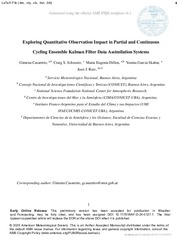Mostrar el registro sencillo del ítem
Exploring Quantitative Observation Impact in Partial and Continuous Cycling Ensemble Kalman Filter Data Assimilation Systems
| dc.contributor.author | Casaretto, Gimena | |
| dc.contributor.author | Schwartz, Craig S. | |
| dc.contributor.author | Dillon, María Eugenia | |
| dc.contributor.author | García Skabar, Yanina | |
| dc.contributor.author | Ruiz, Juan José | |
| dc.date.accessioned | 2025-04-30T18:18:19Z | |
| dc.date.available | 2025-04-30T18:18:19Z | |
| dc.date.issued | 2025-04-18 | |
| dc.identifier.citation | Casaretto, G., C. S. Schwartz, M. E. Dillon, Y. Gracia Skabar, and J. J. Ruiz, 2025: Exploring Quantitative Observation Impact in Partial and Continuous Cycling Ensemble Kalman Filter Data Assimilation Systems. Wea. Forecasting, https://doi.org/10.1175/WAF-D-24-0127.1, in press. | es |
| dc.identifier.issn | 1534-7486 | |
| dc.identifier.other | https://doi.org/10.1175/WAF-D-24-0127.1 | |
| dc.identifier.uri | http://hdl.handle.net/20.500.12160/3004 | |
| dc.description | Fil: Casaretto, Gimena. Servicio Meteorológico Nacional. Dirección Nacional de Ciencia e Innovación en Productos y Servicios. Dirección de Productos de Modelación Ambiental y de Sensores Remotos; Argentina. | es |
| dc.description.abstract | This study applies the Ensemble Forecast Sensitivity to Observation Impact (EFSOI) technique to two 80-member ensemble Kalman filter (EnKF) data assimilation (DA) systems over the United States, differing only in cycling strategy: continuous cycling (CC) and partial cycling (PC). EFSOI calculations were performed using 1-hour, 6-hour and 12-hour evaluation forecast times, verified against the Rapid Refresh Model (RAP) analysis. Beneficial impact rates indicated that most observations were beneficial for both DA systems and forecast times, with no significant difference between PC and CC. Differences in cumulative observation impacts were statistically significant only for sources with few observations and small impacts, like mesonet observations. For numerous and impactful observations, such as rawinsondes and aircraft, differences were not statistically significant, suggesting similar use of important observations by PC and CC. PC forecasts were better than CC forecasts, but this improvement is not clearly due to better use of observations. Variable-wise analysis showed similar behavior between PC and CC for impact rates and cumulative impacts of U, V, T, RH, and surface zonal wind. Overall, there was no evidence that either PC or CC systematically used observations better, with mixed results across observation types and sources. Differences between PC and CC were typically small and not statistically significant for the most impactful observations and variables. Fundamental methodological differences between PC and CC did not significantly impact their ability to assimilate observations, the process of ingesting global fields likely responsible for improved PC forecasts relative to CC. | es |
| dc.format | application/pdf | |
| dc.language.iso | eng | es |
| dc.publisher | American Meteorological Society | es |
| dc.rights | info:eu-repo/semantics/openAccess | es |
| dc.rights | https://creativecommons.org/licenses/by/2.5/ar/ | es |
| dc.rights | info:eu-repo/semantics/openAccess | es |
| dc.subject | Observation impact | es |
| dc.subject | EFSOI | |
| dc.subject | Ensemble Kalman filter | |
| dc.subject | Data assimilation | |
| dc.subject | CC | |
| dc.subject | PC | |
| dc.subject | Rapid Refresh Model | |
| dc.title | Exploring Quantitative Observation Impact in Partial and Continuous Cycling Ensemble Kalman Filter Data Assimilation Systems | es |
| dc.type | Artículo | es |
